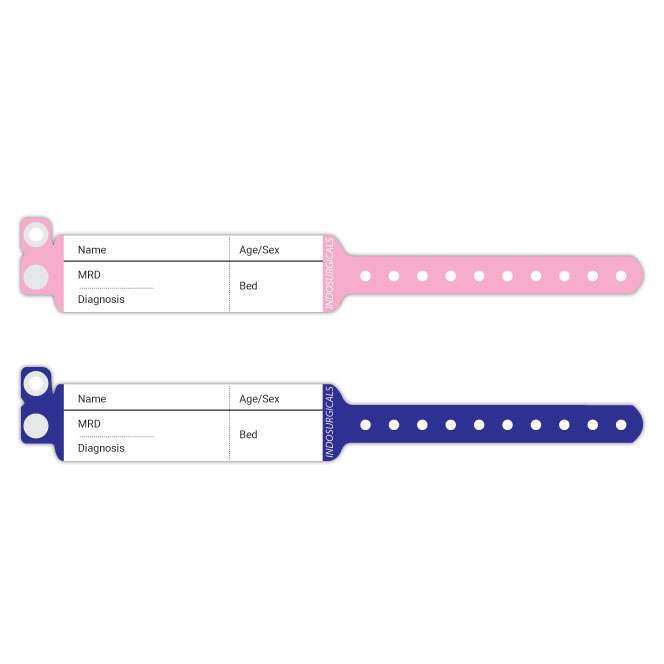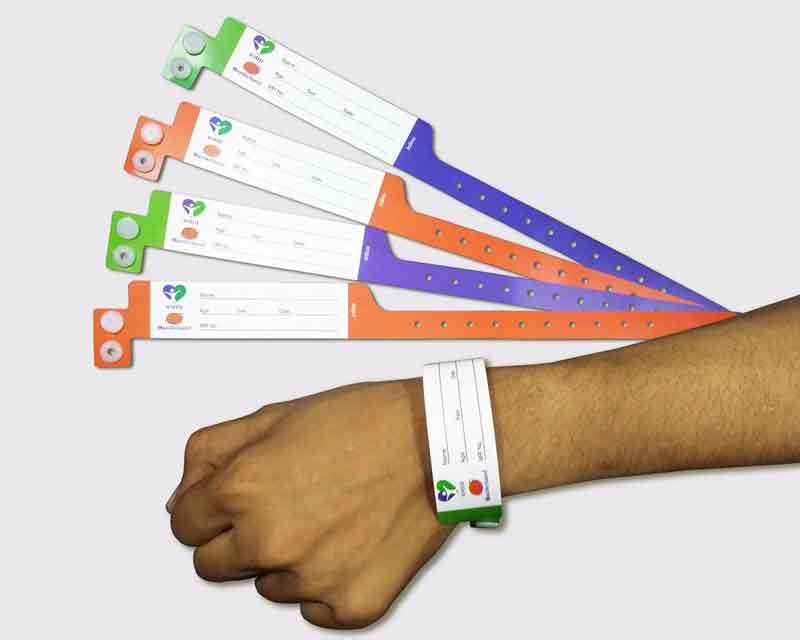The Science Behind the Patient Identification Band: How It Actually Reduces Risk
The Science Behind the Patient Identification Band: How It Actually Reduces Risk
Blog Article
The Function of Person Identification Band in Preventing Medical Errors and Improving Outcomes
In healthcare, individual identification bands are more than simply wristbands; they're fundamental devices that aid avoid mistakes and improve outcomes. It comes to be clear exactly how crucial these bands are in making certain patient safety and security when you think regarding the dangers entailed in misidentification. They carry necessary info that can boost and improve processes interaction. What happens when these systems fall short, and just how can we discover from those circumstances?
Recognizing Person Recognition Bands
Person identification bands are necessary devices in health care settings, making certain that people obtain the correct therapies and medications. These bands typically include vital details, such as your name, date of birth, and an unique recognition number. When you get to a health care facility, personnel rapidly scan your band to match you with your clinical records, treatments, and prescribed medications.
Understanding just how these bands work can boost your experience and safety and security. They not only work as a visual reminder for health care carriers but also aid to stop mix-ups and errors. You'll commonly see a barcode or QR code on the band, which permits for quick digital confirmation of your identity.
Significance of Accurate Individual Recognition

Influence on Individual Security
When health care specialists can not dependably determine individuals, the danger of mistakes enhances significantly, jeopardizing safety and security and treatment outcomes. Exact person recognition is essential for providing suitable care. Individual recognition bands offer as a simple yet efficient device to lessen these threats.
Reducing Medication Errors
When you use an individual identification band, medical care experts can conveniently confirm your identification prior to administering any kind of medication. It's important that you keep this band on during your remain, as it acts as a protect against possible blunders. Keep in mind, your security is a concern, and your recognition band plays a considerable function in guaranteeing you obtain the appropriate therapy every time.
Enhancing Clinical Process Performance
While person recognition bands might seem like a minor information, they significantly improve clinical process efficiency by improving procedures within health care setups. When you properly identify patients, you reduce hold-ups and minimize the demand for recurring checks. By incorporating patient recognition bands into your process, you not only improve effectiveness but likewise contribute to better person results and fulfillment, making your work extra reliable and satisfying.
Common Medical Errors Linked to Misidentification
Misidentification can result in severe clinical mistakes that put clients in danger. You might come across issues like medicine administration errors, wrong surgical procedures, or lab test misconceptions - Patient Identification Band. Comprehending these mistakes is necessary for boosting patient security and care
Medication Administration Mistakes
Medication management errors are alarmingly typical in health care setups, with research studies showing that virtually 1 in 5 people may experience a blunder due to misidentification. Since their identity isn't precisely verified, these mistakes can happen when an individual gets the incorrect medicine, dosage, or administration path. Visualize getting a medication intended for a person else; the consequences can be serious, occasionally leading to negative reactions or perhaps fatalities.
Utilizing an individual identification band especially minimizes these risks by making certain that medical care service providers can rapidly verify your identity. When everyone associated with your care is certain in that you are, the chances of obtaining the proper drug boost significantly. This easy yet effective device plays an essential duty in boosting patient security and improving total healthcare results.
Surgery Errors
Errors during operations can have damaging influences, typically originating from the failing to precisely recognize people. Picture undergoing surgical procedure just to uncover that the wrong treatment is done on you. This headache circumstance often results from misidentification, where surgical groups wrongly run on the incorrect individual or body part. You may assume this is unusual, but it occurs regularly than you would certainly think. Having a reputable patient recognition band can considerably lower these errors. It assists ensure that everyone involved in your treatment is on the same web page when you use a band that plainly mentions your identity and treatment. By prioritizing accurate client recognition, you can help stop medical mistakes and improve outcomes on your own and others.
Lab Examination Misconceptions
When you think of the effect of client misidentification, lab test false impressions could not be the first concern that comes to mind, yet they can cause serious wellness risks. Due to the fact that your sample was blended up with a person else's, picture receiving inaccurate examination results. This can cause misdiagnoses, inappropriate treatments, and delays in care. An incorrect positive for a critical condition could lead to unnecessary procedures, while an incorrect unfavorable might stop you from getting necessary therapy. Correctly recognizing patients with exact recognition bands assists ensure that lab tests are linked to the appropriate individual. By minimizing misidentification, you minimize the threat of harmful mistakes and enhance total client safety and security and end results.
Technologies Enhancing Person Identification Bands
As healthcare proceeds to evolve, innovations enhancing person recognition bands are becoming significantly critical for assuring safety and security and efficiency. You'll find that advancements like RFID (Radio Regularity Recognition) and NFC (Near Field Communication) technology make patient identification bands much more reliable. These attributes permit fast scanning, reducing the chances of misidentification.

Additionally, mobile applications that interact with these bands can even more boost interaction amongst healthcare groups. By utilizing these modern technologies, you can substantially decrease errors and boost person end results. Welcoming these innovations warranties that person identification bands continue to be a central element in your medical care setup.
Executing Individual Recognition Protocols
Carrying out robust patient recognition procedures is essential for ensuring that every person gets the correct treatment without delay. Begin by establishing a standard procedure for individual recognition at every touchpoint-- from admission to release. Use two one-of-a-kind identifiers, such as the client's name and day of birth, to decrease errors.
Train your staff extensively on these protocols, highlighting the relevance of double-checking details prior to waging any therapy or medicine (Patient Identification Band). Regular audits can assist you determine spaces in compliance and areas for improvement
Don't neglect to involve clients in the procedure. By cultivating a culture of safety and caution, you can aid prevent medical errors and enhance total patient end results.
Instance Researches: Success Stories in Individual Safety
Success tales in client safety and security highlight the substantial impact of reliable individual identification techniques. In you could try here one medical facility, the application of color-coded wristbands resulted in a 40% decrease in medication mistakes. Personnel swiftly acknowledged individuals' allergies and problems, advice making sure risk-free therapies.
An additional center took on barcode scanning for medication management, which drastically cut down on negative medication occasions. Nurses reported feeling a lot more certain in their capacity to verify patient identities and therapy strategies.
In a pediatric device, parents were associated with the recognition process, leading to boosted communication and interaction. This partnership not just boosted safety and security however likewise fostered trust in between family members and health care suppliers.
These examples show that when you prioritize accurate recognition, you can significantly enhance individual outcomes and safety. Embracing these techniques creates a culture of vigilance, inevitably guaranteeing patients get the best care at the best time, every time.
Future Fads in Individual Recognition and Safety
With innovation progressing swiftly, the future of person identification and safety is poised for considerable makeover. You'll likely see an increased assimilation of biometric remedies, such as fingerprint or face acknowledgment, making identification quicker and more accurate. These methods can help eliminate mistakes brought on by similar names or miscommunication.
Man-made knowledge will certainly also play a key function, examining person data to flag potential threats and guarantee that safety methods are followed regularly. If a patient's information does not match their therapy plan., envision a system that alerts you promptly.
In addition, wearable innovations could come to be widespread, allowing real-time tracking of individual status and boosting recognition processes. As these innovations unravel, you'll discover that ensuring patient safety becomes extra dependable and efficient. Embracing these fads suggests staying ahead in the mission to decrease clinical mistakes and enhance general outcomes in healthcare.
Frequently Asked Concerns
Exactly How Are Individual Recognition Bands Produced and Kept?
You create person identification bands using certain software that creates distinct barcodes or QR codes. On a regular basis update the info and check to assure accuracy, and train personnel on proper use Recommended Reading to maintain performance over time.
What Materials Are Utilized in Client Recognition Bands?
Patient identification bands are generally made from sturdy products like plastic or plastic. You'll discover they're made to endure wear and tear while making sure clear exposure of essential info for health care service providers during therapy.
Can Individuals Personalize Their Recognition Bands?
Yes, you can usually tailor your recognition bands, depending upon the center's plans (Patient Identification Band). Individualizing them with shades or layouts could aid express your preferences, making your experience feel much more comfy and distinct throughout your care
How Frequently Should Individual Recognition Bands Be Changed?
You ought to change person identification bands whenever they become harmed, soiled, or unreadable. Routine checks are important to guarantee they're exact and always clear, which aids keep effective communication and safety and security throughout your care experience.
What Happens if a Band Is Damaged or Lost?

If a band's harmed or lost, you require to inform the healthcare team right away. They'll change it to guarantee accurate identification, protecting against possible mix-ups and making certain you obtain the correct therapy and medications.
Individual identification bands are necessary tools in medical care settings, ensuring that individuals get the correct treatments and medicines. By incorporating individual recognition bands right into your process, you not just boost effectiveness yet also add to better individual end results and fulfillment, making your work more rewarding and effective.
You'll discover that developments like RFID (Radio Frequency Identification) and NFC (Near Area Communication) modern technology make individual identification bands more reliable.Carrying out durable person recognition methods is crucial for making sure that every person gets the right treatment without delay.Success tales in patient safety and security highlight the considerable influence of effective individual recognition practices.
Report this page